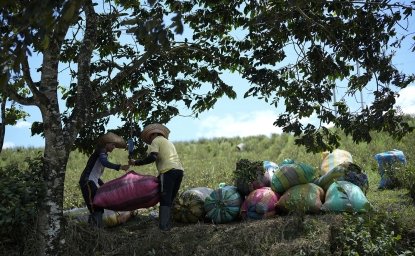
A blog of the Wilson Center
Those captured or killed by Hamas militants on October 7, 2023, included nationals of 25 different countries. The invaders used bullets and bombs, drones and missiles, and other instruments of war that came from, or contained parts from, Iran, Russia, China, North Korea, and elsewhere.
While Hamas led the horrific October 7 terrorist attack on civilian targets in Israel that killed nearly 1,200 people and wounded thousands of others, at least 5 other designated terrorist organizations took part. One day after the initial attack, Iranian-backed Hezbollah launched rockets and artillery into Shebaa Farms in Northern Israel, and Yemen-based Houthi leaders both congratulated Hamas for their attack on Israel and promised that their forces were ready to participate “[with] missile bombing, drones, and military operations” against Israel and Israel’s allies. The Houthis followed through on that promise the following month by launching missiles against Israel and with attacks on almost 100 ships in the Red Sea with links to the US, Israel, and the UK. The Houthis also struck ships owned by, or flying the flag of, numerous countries from as far away as Ukraine, Greece, the Marshall Islands, Barbados, and others.
The October 7 attack was conducted by land and air; it involved guns, rockets, missiles, and drones, which were supplied by, or contained parts from, numerous countries. For example, sniper rifles and drones came from Iran, rifles were from Russia and China, and rocket-propelled grenades had origins in Bulgaria and North Korea.
The victims of the attack were also from many countries in addition to Israel. Seventy-nine of those killed were foreign nationals. Of the estimated 251 people captured by militants (including 90 women and 36 children), captives were from 25 different countries, including the US, Argentina, Germany, France, Russia, Thailand, Nepal, Tanzania, the Philippines, China, and Sri Lanka. Reports say that 101 hostages are still unaccounted for, including 7 Americans taken by terrorist militants.
Of course, the assistance which Palestinians in Gaza depend upon for survival is also very much an international matter… originating far from Israel and West Bank-Gaza. Even prior to October 7, Gaza had one of the world’s highest unemployment rates, 80% of its residents lived in poverty, and 62% of Gazans relied on donated food assistance. In early 2023, the United Nations office for the Coordination of Humanitarian Affairs estimated that 2.1 million Palestinians needed more than $500 million in humanitarian assistance.
While a number of countries contribute to the UN’s humanitarian efforts, the US is far and away the largest donor. Since USAID was established 60 years ago, the US has provided more than $7 billion in humanitarian and development aid to the Palestinian territories. With Israel’s response to October 7, an estimated 1.9 million Palestinians in Gaza (out of a population of approximately 2.2 million) have been displaced and 2.1 million need humanitarian assistance such as food aid. To be sure, multiple countries have provided humanitarian assistance to Gaza since last October, including the United Arab Emirates (the largest provider of such assistance in the region), the EU, and others, but the US has been easily the largest provider—giving approximately $1 billion in funds and material support since the Hamas attacks.
To put it another way, the weapons of war on October 7 came from or contained parts from a range of countries. Those killed or taken captive were nationals of many countries. Since the initial attack, Hezbollah has been attacking Israel from its positions in Lebanon, and the Houthis have been attacking not only Israel, but individuals and ships of numerous countries. And Iran is the state sponsor of terrorism and patron of Hamas, Hezbollah, the Houthis, and other terrorist proxies.
World leaders are rightly concerned that we are at risk of a much wider conflict. But shouldn’t we also acknowledge that October 7 has always been more than merely a fight between Hamas and Israel?
This blog was researched and drafted with assistance from Dhruvi Thakker, Chelsea Acheampong, and Katherine Schauer.
Author


Middle East Program
The Wilson Center’s Middle East Program serves as a crucial resource for the policymaking community and beyond, providing analyses and research that helps inform US foreign policymaking, stimulates public debate, and expands knowledge about issues in the wider Middle East and North Africa (MENA) region. Read more

Explore More in Stubborn Things
Browse Stubborn Things
Not-So-Renewable Energy in Zambia

Colombia's Cocaine Moment of Truth

There's Mining, Then There's Galamsey

